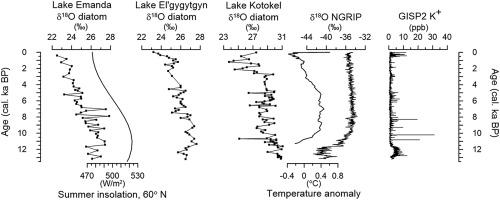Quaternary Science Reviews ( IF 3.2 ) Pub Date : 2021-03-27 , DOI: 10.1016/j.quascirev.2021.106905 Svetlana S. Kostrova , Boris K. Biskaborn , Luidmila A. Pestryakova , Francisco Fernandoy , Marlene M. Lenz , Hanno Meyer

|
A new dataset from Lake Emanda provides insights into climate and environmental dynamics in an extreme continental setting in northeastern Siberia. The δ18Odiatom record is supported by diatom assemblage analysis, modern isotope hydrology and atmospheric circulation patterns. The data reveal a relatively cold oligotrophic freshwater lake system persisting for the last ∼13.2 cal ka BP. Most recent δ18Odiatom (+21.5‰) combined with present-day average δ18Olake (−16.5‰) allows calculating Tlake (∼21 °C), reflecting summer conditions. Nonetheless, the δ18Odiatom variability is associated with changes in δ18Olake rather than with Tlake. An obvious shift of ∼2‰ in the δ18Odiatom record at 11.7–11.5 cal ka BP accompanied by significant changes in diatom assemblages reflects the onset of the Holocene. Relatively high δ18Odiatom during the Early Holocene suggests relatively warm and/or dry climate with associated evaporation effects. The absolute maximum in δ18Odiatom of +27.7‰ consistent with high values of diatom indices at ∼7.9–7.0 cal ka BP suggests a Mid Holocene Thermal Maximum. A continuous depletion in δ18Odiatom since ∼5.0 cal ka BP is interpreted as Middle to Late Holocene cooling reaching the absolute minimum at 0.4 cal ka BP (i.e. the Little Ice Age). An overall cooling trend (∼0.3‰ 1000 yr−1) throughout the Holocene follows decreasing solar insolation. The pattern of the Lake Emanda δ18Odiatom record is similar to that obtained from Lake El’gygytgyn suggesting a common “eastern” regional signal in both records, despite their hydrological differences. Presently, atmospheric moisture reaches the study region from the west and east with ∼40% each, as well as ∼20% from the north.
中文翻译:

西伯利亚东北部晚新世过渡和全新世的气候和环境变化:来自埃曼达湖的硅藻氧同位素和组合物组成的证据
来自埃曼达湖的新数据集提供了对西伯利亚东北部极端大陆环境中气候和环境动态的见解。该δ 18 Ø硅藻记录由硅藻组合分析,现代同位素水文学及大气环流模式的支持。数据表明,相对寒冷的贫营养淡水湖泊系统在最后一个〜13.2 cal ka BP持续存在。最近的δ 18 ö硅藻结合本天的平均δ(+ 21.5‰)18 ö湖(-16.5‰)允许计算Ť湖(~21℃),反映夏季条件。尽管如此,δ 18 Ø硅藻变异与δ变化有关18 O湖而不是T湖。在δ的〜2‰一个明显的转变18 Ø硅藻记录在11.7-11.5 CAL万年BP伴随硅藻组合显著的变化反映了全新世的开始。相对较高的δ 18 ö硅藻早期全新世建议相对温暖和/或干燥的气候具有相关联的蒸发效果。在δ绝对最大18 Ø硅藻在~7.9-7.0 CAL万年BP的+ 27.7‰,硅藻指数的高值一致表明中端全新世热最大。连续耗尽δ 18 ö硅藻因为〜5.0 cal ka BP被解释为全新世中期至晚期冷却,在0.4 cal ka BP时达到了绝对最小值(即小冰期)。整个全新世的总体冷却趋势(〜0.3‰1000 yr -1)跟随日照减少。湖Emandaδ格局18 Ô硅藻记录类似于从El'gygytgyn湖建议一个共同的“东”区域中均有记载信号获得,尽管他们的水文分歧。目前,大气湿度从西部和东部分别到达研究区域,分别约40%和北部约20%。











































 京公网安备 11010802027423号
京公网安备 11010802027423号